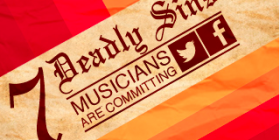In business, return on investment – or ROI – traditionally translates to “How much money did we make on that promotion or venture?” This doesn’t translate so neatly to a social media marketing campaign, or your general social media efforts, because at its heart, social media is a conversation tool, not a sales tool.
Because of this, many musicians, entrepreneurs, and even well-established brands find themselves struggling with the concept of spending hard-earned (and limited) funds on any sort of social media marketing strategy. It’s understandable. If you invest $1,000 into a promotion, wouldn’t you like to know that you’ll be able to draw a direct line to the resulting revenues that are made from album sales, ticket sales, merch sales, etc.?
It would be nice, but the truth is you probably won’t be able to. The purpose of social media is not, in and of itself, to increase sales. Social media is a suite of tools that can be used to engage with a target market. It exists to help people, bands, and brands reach out to existing and potential fans to:
- Have conversations
- Build trust
- Increase visibility and influence
So the question becomes: “If social media has no direct relationship to sales, how do I measure its ROI?” It will help if you start by defining realistic expectations of your social media marketing campaigns so you can effectively measure the ROI of your social media efforts.
Market research
As an emerging musician, understanding who your fans are can help you on every level. From putting together a content strategy, to creating a product line, to planning a tour, and even the set list for each show, understanding exactly who your fans are, where they live, what they are interested in, and what drives them can help you take the guess work out of how you present the public face of your act.
Whether you are focusing your marketing on a local, national, or even global scale, social media has the power to do just this and should be considered as a critical focal point of any social media campaign.
What is your ROI here?
A better understanding of your target market helping to you create a more direct path to a successful, sustainable fan base.
There are several things you can examine that will help you to better identify your fans:
1. Demographics (age, location)
Understanding the age and location of your fans will help you to book shows more effectively and develop products (e.g., merch, formats for your music) that are most appropriate for your fan base.
This information is quite easily obtained online, as most social media platforms give you at least basic analytics that include demographics. However, if you’re looking for a more robust set of tools, there are dedicated analytics services available such as Next Big Sound and Hootsuite that allow you to drill down deeper into your target market to get to know them better.
2. Psychographics (attitudes, interests, values)
Understanding the interests, values, and attitude of your fan base is the key to creating a consistent, compelling content strategy, which is critical to building your band’s visibility, relevance, and influence online.
Finding this information online may take a bit more digging. The most obvious and direct way to find this information is to simply ask your fans by way of a survey. Two inexpensive survey options are Survey Monkey and Poll Daddy, which can be shared through all social platforms as well as your blog and newsletter.
Of course, another way to find this information is to take a sample of your fan base and explore their social media habits:
- What pages have they “liked” on Facebook?
- What topics are they tweeting about?
- Do they like sharing photos?
- What is the subject matter of the content that they are sharing online (personal, tech, entertainment, religious, political, etc.)?
This may take time, but doing a survey as well as taking a sample and diving in further can help you identify key psychographics that were previously hidden to you.
3. What time (of the day AND day of the week) your fans are actually online
Critical to building engagement is understanding exactly when your fans (or target fans) are actually online to maximize your efforts and make sure they’re receiving your message. There are too many studies that show conflicting data regarding when you should post, tweet, or email, and that is because each market is different. You need to know when YOUR fans are online, not when “the average person” is online.
There are services available, such as SocialBro and Crowdbooster, that can analyze your posts, tweets, etc., and tell you exactly which times are the most likely for your content to be engaged with.
Capturing “super fans” via a mailing list
Once you have identified your fans, the next logical step is to find a way to capture their email addresses so that they can be marketed to directly for things like new product releases, tours, and whatever exclusive offerings you can come up with.
This is done most effectively by capturing your fans through a mailing list, which is ultimately the ONLY way to achieve direct interaction with your fans because, remember, your fans have to be online in order for your posts to be engaging. Online posts are often missed, but a direct email will be waiting for your fans in their own personal inbox.
This action of capturing fans is a fantastic way to frame a social media management campaign as it can give you a tangible number to focus on – building your list is a growth percentage number that actually matters.
What is the ROI of a social media campaign that focuses on building mailing list subscribers?
In short, it’s the ’80/20 rule.’ This economics concept, which states that 80% of the world’s wealth comes from 20% of the world’s population, can be translated to the music business – 80% of a musician’s revenue will come from the top 20% most loyal fans.
Whether these percentages are exactly correct or not isn’t the point. What IS the point is that if you can find and capture your most loyal fans, you have a way to directly interact with and sell to those who are likely to make up the majority of your overall revenue.
There are almost too many email management services to name, but Fanbridge, Reverbnation, and Mail Chimp are all great options for musicians looking to build a mailing list and start a newsletter.
Each of the above services all offer something called an “e-for-m” widget (email for media) that allows you to offer your fans some piece of media, be it a song, video, PDF, etc., in exchange for an email address.
This widget can be embedded into your website, blog, Facebook fan page, and anywhere else that allows you to use HTML embed code (similar to a YouTube video). The trick to effectively capture your super fans is to:
1. Offer something exclusive and worthwhile. Email can be a very personal thing since it goes with people everywhere they go. Fans need to feel like they are truly getting something of value in return for giving their email address away.
2. Maintain an active newsletter. This means that once per month, you should have a newsletter that is sent out with a personal message, exclusive content, and one specific call to action. (NOTE: For a newsletter, more is NOT better. Unless you have content to support your outreach, sending out a newsletter too frequently can result in a large number of unsubscribes).
Engagement and chatter
If the fundamental purpose of social media is to be a conversation tool (not a sales tool), than an obvious frame for a social media campaign should be just that… measuring the level of conversations that take place because of the campaign.
These conversations can be broken down into separate categories: engagement and chatter. Engagement is the internal conversations taking place between you and your fans. Chatter is the external conversations started by others (bloggers, podcasters, fans, etc.) about you.
What is the ROI of a social media campaign that focuses on chatter/ engagement?
While this type of analysis is a bit more abstract than others that have specific, tangible results you can analyze, this campaign will give you a boost in overall visibility and influence within your niche. It is this influence and visibility (aka credibility) that is often the missing piece of the puzzle that opens doors to new opportunities that can help you take your career to the next level.
Engagement will always be most easily tracked through your own social analytics (as mentioned earlier). Chatter is a bit more difficult because this is an external conversation and won’t be tracked by your internal social analytics reports. But not to fret, there is an excellent, free option for you to use!
Google Alerts will track and report any time your name (or any other key word that you set, such as an album name, track name, etc.) pops up on the Internet. Once an alert is created, Google will report any mentions of the targeted keywords back to you via email at your desired frequency (these reports can be sent anywhere from monthly all the way down to real time, sending a new email every time a new mention is indexed by Google).
Framing social media to fit your needs
The options above are not the only ways to frame a social media campaign. The reality is that as long as you understand that social media is simply a conversation tool, and not a sales tool, you can frame a campaign utilizing these tools in any way that makes sense for your own goals and career path.
We would love to hear from all of you below in the form of a comment to discuss how YOU have framed your social media campaigns in order to effectively track ROI.






